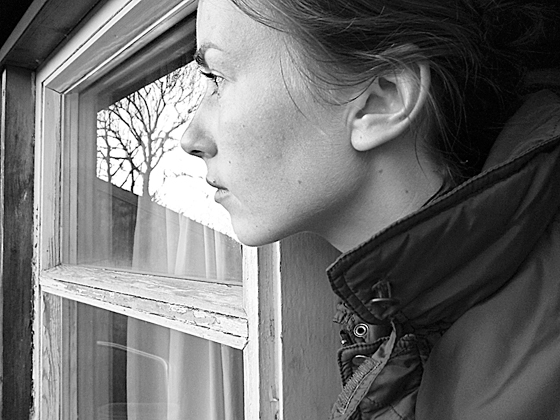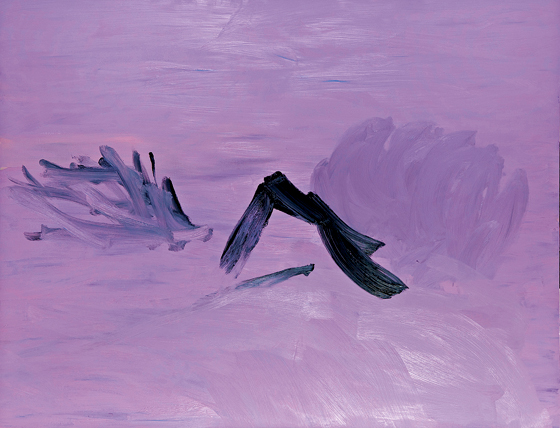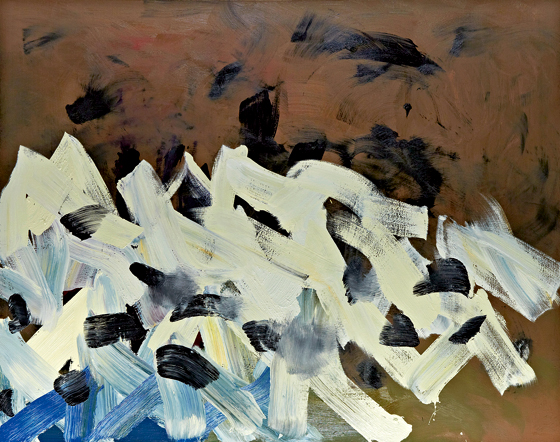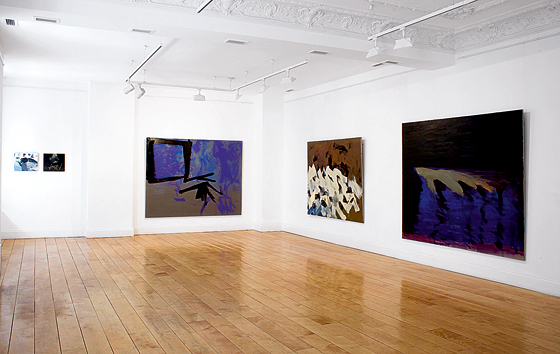|
|
| The phenomenological vision of Daiga Krūze Laine Kristberga, Screen Media and Art Historian Daiga Krūze. Hideout 11.02.2013.–02.04.2013. Gallery Alma | |
| In an interview that was published in honour of the exhibition Hide out opening at the gallery Alma, Daiga Krūze says: “Last year I painted a pine needle, and this image encompassed both the pleasant and the painful. You can look at the needle only, or you can also step on it barefoot and the needle may prick you painfully. Thus I also paint reality.”(1) This existential conclusion reveals the artist’s phenomenological vision of the world and manifests an interest in the ontological order of things. It must be added that in art history the marriage of art and philosophy is nothing strange. In the context of phenomenology and existentialism, art as a philosophical cognition mode has been discussed by Friedrich Nietzsche, Martin Heidegger, Maurice Merleau-Ponty, Jean Paul Sartre and many others. Although not an easy task, I will try to analyse the works of Krūze through the prism of phenomenology, attempting to interpret the bodily experience between seeing and the seen, a phenomenon and being. After all, the artist, too, admits that in her exhibition Hideout she has turned to the subject of the human being “who does not see himself or herself, but who senses”(2). Along with the titles of paintings, a semantic role is also played by the words of Nina Si- mone’s song “Ain’t Got No / I Got Life”. Although in the history of slavery and discrimination in the USA the context of the song is different, Krūze evidently has heard in its words the theme of body celebration. Simone sings about the fact that the body ensures our existence and we can call it our own, even when we have nothing else – no friends, no love, no education, no culture. | |
 Daiga Krūze. 2013 Publicity photos Courtesy of the artist | |
| The borderline between the felt and the imagined is not so easily drawn. Objects, people, space, time and other kinds of experi- ences that make up our daily lives can be explained in words that are as if selfevident, for instance: ice is cold; a glass is an object in which to pour liquid, etc. And yet, the fact that we have a certain vocabulary that we may use to describe the surrounding world does not mean that this lexis explains the true essence of things. It is Sartre who discusses the problem of articulation of the sensed and the mentally pictured in his novel ‘Nausea’: “Black? The root was not black, there was no black on this piece of wood – there was... something else: black, like the circle, did not exist. I looked at the root: was it more than black or almost black? But I soon stopped questioning myself because I had the feeling of knowing where I was. Yes, I had already scrutinized innumerable objects, with deep uneasiness. I had al ready tried–vainly–to think something about them: and I had alrea dy felt their cold, inert qualities elude me, slip through my fingers.”(3) Correspondingly the task of phenomenology is to help us to think over the basic terms which we use as a set of instruments for studying what it means to be a human being, to be embodied. For instance, Maurice Merleau-Ponty states that “all of (phenomenology’s) efforts are concentrated upon reachieving a direct and primitive contact with the world, and endowing that contact with a philosophical status”.(4) According to Merleau-Ponty, the body is the primordial situation of our being, and this statement has overthrown the dimension of being human that has been considered the very root of our existence since Descartes – our consciousness. Phenomenology insists that consciousness – our awareness of our selves, other people, objects, etc. – is rooted in our experience of the world and this experience is, in turn, rooted in our bodies. Hence phenomenol- ogy rejects the famous Cartesian statement cogito ergo sum (“I think, therefore I am”) and the mindbody dualism that this proposition positions as a “given” feature of our being. MerleauPonty’s answer to Descartes sounds like this: “The world is not what I think, but what I live through."(5) | |
 Daiga Krūze. Touch of Seconds. Oil on canvas. 170x220 cm. 2012 Publicity photos Courtesy of the artist | |
| The lived through, bodily experience can provide a new way of seeing the world, the human being and existence. So, for instance, phenomenologists tend to the opinion that an object and the body are made of one and the same existential material. Correspondingly, there may be situations when inanimate things are attributed human qualities or, in other words, anthropomorphism is evident. Sartre describes a situation where trees smile back at him: “I got up and went out. Once at the gate, I turned back. Then the garden smiled at me. I leaned against the gate and watched for a long time. The smile of the trees, of the laurel, meant something; that was the real secret of existence.”(6) The French painter Andre Marchand, referencing Paul Klee, also writes that things look at him: “In a forest, I have felt many times over that it was not I who looked at the forest. Some days I felt that the trees were looking at me, were speaking to me... I was there, listening... I think that the painter must be penetrated by the universe and not want to penetrate it... I expect to be inward ly submerged, buried. Perhaps I paint to break out.”(7) Marchand’s in- terpretation, possibly, sounds more metaphysical than existential, however, the conclusions drawn by both Sartre and Marchand based on corporeal experience attest to a phenomenological perception of existence. As stated by Merleau-Ponty, “visible and mobile, my body is a thing among things; it is one of them. It is caught in the fabric of the world, and its cohesion is that of a thing”.(8) It seems that in Krūze’s creative process, too, a crucial role is played by the opportunity of being in nature, of listening to it and becoming part of it. The titles of the eight largescale and three small format works that can be viewed at the exhibition evoke associations with a landscape, a meadow, a forest, its inhabitants. For example, two titles among the paintings feature a bear: Lāča smiekliņi (‘A Giggling Bear’, 2013), and Ķeksēšana. Lāča ķepa (‘Scooping it Up. Bear’s Paw’, 2013). The works have been painted in the manner of abstract expressionism, and the viewer’s task is not to attempt to see anything realistic or cognitively recognisable in them, however, thanks to the titles, associative thinking is set off. For instance, the brown and white swathes of colour in ‘A Giggling Bear’ definitely make one see a laughing bear. The titles also hint at a desire to paint some- thing that is impossible – a swift movement that the human eye is unable to decipher, a sound or smell, for instance, as in the work titled Koku smaržošana (‘Sweet Smelling of Trees’, 2012). As the artist herself admits, “although the event sounds absurd, nevertheless it is possible to imagine and interpret the little fantasized moments”(9). Sartre, also, asserts something similar, saying that “the world of ex planations and reasons is not the world of existence” and that “a movement, an event in the tiny coloured world of men is only relatively absurd: by relation to the accompanying circumstances”.(10) | |
 Daiga Krūze. A Giggling Bear. Oil on canvas. 150x190 cm. 2013 Publicity photo Courtesy of the artist | |
| In fact, the choice to paint situations that are as if absurd and located only in her fantasy must be treated as an attempt to break free from the restrictions of theories and the dogmatism of the mind. Krūze paints the imaginary, however, these images and situations, for example, lunch with the Moon and the forest’s celebrations of the hundredth day, are based on bodily impulses and feelings: hearing, touch, perception. The body itself – at least in this exhibition – never becomes the subject of Krūze’s works, yet at the same time the body is a medium that ensures the artist’s dialogue with the world. According to Merleau-Ponty, the body is the thing that makes art possible: “Indeed we cannot imagine how a mind could paint. It is by lending his body to the world that the artist changes the world into paintings.”(11) In this context it could be useful to apply the concept of the schweben, coined by German philosopher and founder of German idealism Johann Gottlieb Fichte. In English this could be translated as oscillation, hovering, floating or vibrations. The notion of schwe ben can be related also to the oscillation of imagination “between the finite and the infinite, the determined and the determinable”. For instance, art historian Violetta Waibel applies Fichte’s concept when analysing Mark Rothko’s paintings. She is of the opinion that on experiencing Rothko’s works, “we initially encounter the... finely nuanced fields of colour as contrasts”, but after looking longer at the works “the painting as a whole becomes a colour landscape with the suggestion of depth and, of especial significance, an horizon.” Actually, Fichte’s concept of schweben helps interpret, as well as articulate, “how Rothko in this interplay of colour and “object” (i.e., the horizon) tries to stage an emotional drama” for viewers.(12) In Krūze’s works, too, it is possible to sense the presence of landscape and nature, although it is often accompanied by the feeling that you are in an express train and the landscapes flitting by are merely flashing, vibrating blocks of colour. It is no coincidence that the ti- tles of works also evoke associations with movement, for instance, Lidojums (‘Flight’, 2012) and Vējošanās. Galops ar braucošu mašīnu (‘Breezing. Gallop in a Moving Car’, 2012). Besides, the artist has admitted that this has been one of her favourite subjects ever since her first exhibition. There are no figural elements evident in the works, the paintings are free of objects, though this cannot be referred to Krūze’s handwriting in general. For instance, in comparison to paint- ings done in 2006, 2008 and 2009, the landscapes depict both a horizon as well as objects and images – people, dogs, birds, cars. | |
 Daiga Krūze. View from the exhibition Hideout. 2013 Publicity photos Courtesy of the artist | |
| I would like to claim that Daiga Krūze is an artist – phenomenologist, who tries to turn daily experiences and perceptions into a form of expression or, in the words of Paul Cezanne, into an artistic gesture, imbuing it with philosophical content. This, of course, does not mean that art can only emerge if the artist is a philosopher, or creates works declaring philosophical statements. Most likely, such an approach would only diminish the meaning of the work of art and cause it to become posterlike. However, in the case of phenomenology the possibility of art is not explained by some mystical inner ar- tistic energy or the qualities of a genius, but with an artist’s body that, like the instrument between “the eye and mind” as defined by Merleau-Ponty, unites the ability to perceive and to create: “A human body is present when, between the seeer and the visible, between touching and touched, between one eye and the other, between hand and hand a kind of crossover occurs, when the spark of the sensing/ sensible is lit, when the fire starts to burn that will not cease until some accident befalls the body, undoing what no accident would have sufficed to do...”(13) And, as manifested by the excellent works of Krūze, the spark between the sensing and the sensible is definitely ignited! 1 www.arterritory.com/lv/teksti/intervijas/1985-striktu_robezu_nav,_ir_kartu_ kartas/ (accessed 04.04.2013.). 2 Ibid. 3 users.telenet.be/sterf/texts/phil/Sartre-Nausea.pdf (accessed 15.04.2013.). 4 Art and Phenomenology. Ed by Joseph D. Parry. Oxon; New York: Routledge, 2011, pp. 5–6. 5 Ibid. 6 users.telenet.be/sterf/texts/phil/Sartre-Nausea.pdf (accessed 15.04.2013.). 7 Charbonnier, Giacometti. Le Monologue du peintre. Paris: R. Julliard, 1959, pp. 143–145. 8 www.biolinguagem.com/biolinguagem_antropologia/merleauponty_1964_ eyeandmind.pdf (accessed 15.04.2013.). 9 www.arterritory.com/lv/teksti/intervijas/1985-striktu_robezu_nav,_ir_kartu_ kartas/ (accessed 04.04.2013.). 10 users.telenet.be/sterf/texts/phil/Sartre-Nausea.pdf (accessed on 15.04.2013.). 11 www.biolinguagem.com/biolinguagem_antropologia/merleauponty_ 1964_eyeandmind.pdf (accessed 15.04.2013.). 12 Art and Phenomenology, p. 5. 13 www.biolinguagem.com/biolinguagem_antropologia/merleauponty_ 1964_eyeandmind.pdf (accessed 15.04.2013.). | |
| go back | |







